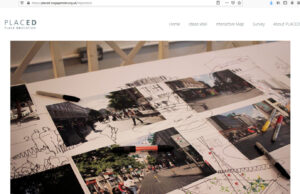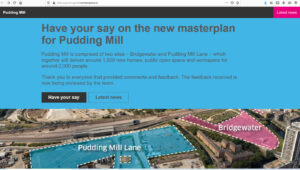When COVID19 forced us to retreat into our social bubbles and our homes, the government needed to make plans so that people could still participate in planning matters that concerned them. Therefore, they issued emergency planning procedure guidelines for local authorities to ‘make any temporary amendments that are necessary to allow plan-making to progress, and that continue to promote effective community engagement’ [1]. Developers, local authorities, community organisations and designers frantically developed temporary solutions, such as digital platforms and apps, to support design participation and to invite responses from local communities and stakeholders. Coinciding with these developments, on the 6th of August 2020 the government published a white paper on Planning for the Future. The white paper proposes radical reforms to the present planning process, to make it ‘simpler, clearer and quicker’. They propose to do this in part by focusing the community participation process at local plan level (i.e. neighbourhood design, pre-project development level, removing it from the planning stage) and by making engagement mainly digital.
In light of this, along with many others, Civic Voice (a national charity for civic engagement in England) wrote a response to the white paper. The paper argues for the need to maintain face-2-face participation alongside digital engagement so that everybody can have their voices heard at all stages of the planning process. In their view, a mix of the physical and digital engagement is required to reach the widest group of people possible and gain the most meaningful feedback. To accompany their response and as part of their ‘Putting community led design at the heart of placemaking’ campaign, they launched a series of lunch-time lectures, ‘Modern Methods of Meaningful Participation’. The lecture series explored the opportunities and barriers surrounding digital community participation in the planning process, particularly around the development of highstreets. I followed three lectures by designers and community facilitators talking about their approaches to digital engagement. The lectures gave a good overview of how design and engagement practitioners perceive the barriers and opportunities of engagement. Some of the lectures can be viewed on the Civic Voice Vimeo site.
The first lecture was given by Charles Champion, a partner at JTP, where he heads their dedicated community planning team. He is also author of ’20/20 Visions: Collaborative Planning & Placemaking’. Champion didn’t focus on new digital approaches or on the high streets specifically, but discussed JTP’s overall methodology, which revolves around gaining trust with the communities they work with. They build relationships and trust by having conversations that take people on a journey in their area. By having these conversations at different junctions of the participation and design process, people in the community feel more engaged and have a chance to see that their opinions and feedback have been taken into consideration in the design proposals. For him a good participatory program is one where the people know when they can engage and have their voice heard and is run openly and transparently.
The planning white paper implied that too much consultation slows the process down, but as Champion stated consultation can easily be run alongside the initial design stages and in fact help the development process. Moreover, not consulting can delay the planning process, as when people feel put upon, they can mobilise and debilitate the progress through various ways of opposition. Champion’s experience is that projects are more likely to gain planning consent, and be made easier and quicker, with a well-run participatory process. He also emphasised that participation in the planning process can’t only be digital, as not everybody has the required digital literacy or the access to digital tools
The second lunchtime lecture was by Jo Harrop from PlacED, a community-engagement and education organisation. PlacED facilitate design conversation with the wider community through creativity and dialogue. Before Covid19 their work was focussed on facilitating physical interaction in pop-up shops, community centres or from their converted ice-cream van which they drive to locations. When they were forced to go online for their digital engagement, they had to do some thinking about how to go about it. They didn’t opt to using the platform Commonplace, which gained a lot of traction in the UK during lockdown. PlacED created their own site on the Social Pinpoint platform, a civic participation platform commonly used in the States and Australia. For PlacED images are an important tool and the platform allowed them to have greater creative control over the site and images. Harrop felt that with the Social Pinpoint Platform, they were able to make things more interactive and focus on dialogue.

What Covid19 highlighted for Harrop in her work was the inequality of space, voice and opportunity in design participation. She felt that it became even more important to listen, empower people and collaborate. It was clear that digital engagement does not fit all: the social, economic and political situations within communities require different approaches.
The last lecture I watched was Mike Sanders CEO of the Commonplace planning participation platform mentioned above. Commonplace saw that the digital engagement demand has increased and has become a more permanent part of the offer in community engagement. They have a unique blended approach for each project, a mix of digital resources, i.e. email, social media, live media and tablet (face2 face). The different channels give them a wide reach of audiences, and unsurprisingly they get a large response from young people who otherwise would not have been aware of their rights and opportunity to engage in the planning process. In his presentation Sanders broke down what tech can bring the participatory process from their experiences.
- Openness to enhance trust. On the Commonplace platform all comments are open to all to read. This is not so on other planning engagement sites where comments might be monitored by council staff admin to curate a discourse. The heat map tool, which is one of their main methods, gives people the chance to highlight any issue, experience or appreciation within their area and rate it as good or bad on a map. The responses to any highlighted event are open (but anonymous) for all to read. Mike explains that this creates a level of genuine listening between the local people as well as with the professional stakeholders, discussing issues in a more effective way, which can create better outcomes for a project. The openness also increased response rates, allowing communities to effectively engage multiple times and helping create continuous conversations.
- A more balanced? representation across sections of a community. Through digital monitoring they can keep track on where and how engagement happens, which can help councils develop more direct engagement strategies to fill in the gaps or reach a larger audience. It is financially hard to reach all the groups with face-2-face activities, which can lead to small NIMBY (not in my back yard) groups developing. But digital can widen the conversation with more community not just the active and loudest few.
- Important to engage early and continuously. Sanders talked about the importance of starting conversations early, so these can feed into the local plan. People are more likely to get involved in strategic plans if they have been engaged in conversations about their place first. And keeping the conversation going, is also important as it is a more effective way to keep the community involved.
- Offline + online. Sanders commented that digital can’t do everything. The data collected digitally can be used to see where certain geographical or demographic groups have been excluded from the process and target them with physical engagement tools.

The main message from all three speakers is clear. Participation requires a mix of digital and physical participation to support each other. Digital can fill in the known gaps of traditional participation (e.g. not reaching young people, not being available at all hours). Digital platforms are also good at informing people and keeping them continually up to date about progress. It is also ideal for collating people’s views and comments on a platform, logging their geographic and demographic details, which can support further development in areas. However, digital might not be so good at building bridges with communities or at giving them a real sense that they can influence the brief development and design process, as mentioned by Champion. There is a need for some face-2-face interaction to build trust and relationships, developing an understanding between the different stakeholders involved. Physical activities are also needed to reach those people that are not as digitally connected, due to digital poverty or lack of media literacy. Each method can cover different and complementary aspects of the participatory design process, to make the whole process more meaningful.
These changes in the way we facilitate community design have important immediate and long-lasting implications on the inclusiveness and accessibility of the participation processes and how they influence the people’s capacity to participate. It raises the need to develop and analyse appropriate approaches in order to understand the impact and implications of the different methodologies and methods, and to establish what the different combinations between digital and face-2-face participatory practices can offer.
Reference:
[1] https://www.gov.uk/guidance/plan-making#covid1 Paragraph 076-078

Leave a Reply